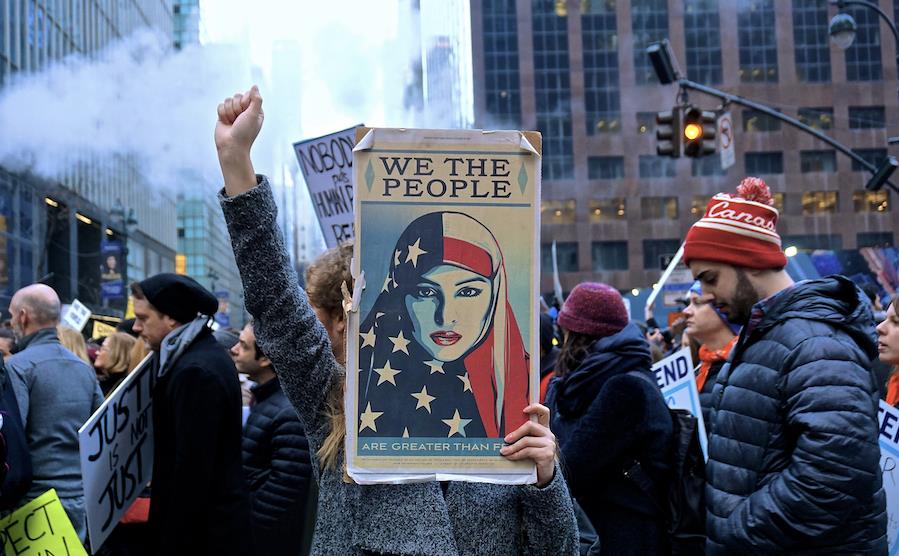Placards have long been used as a protest tool globally. It is not unusual for media to gravitate to the same placards when reporting, recognising their strong design and capacity to capture and entertain audiences. These are the placards that are beamed to the masses each night, their messages burned irreversibly into our memories.
Take the slanderous ‘Ditch the Witch’ placards that fueled the downfall of Julia Gillard, or Michael Agzarian’s ‘HeARTless’ poster of George Brandis rolled out for protests in the wake of funding cuts (2013), and designed in the style of Shepard Fairey’s ‘Hope’ poster used to campaign for Barack Obama’s 2008 election. Most of us can immediately picture these powerful placards.

A protest held outside Malcolm Turnbull’s Wentworth office two days after his election to Prime Minister by internal ballot, September 16, 2015. Courtesy of The National Association for the Visual Arts (NAVA). Photo by Joan Cameron-Smith.
Fairey’s ‘Hope’ placard was later acquired by the Smithsonian Institution for its National Portrait Gallery (USA). Similarly, today there are books written on the art of The Arab Spring (2010-2012), a pivotal example where art was used as a powerful voice when action couldn’t always be taken.
We have since been witness to The Occupy Movement (2011-2012), Spain’s anti-austerity Indignados Movement (2011), Black Lives Matter (2014-2016), The Women’s March (2017-2019), The Umbrella Movement in Hong Kong (2014), to most recently the growing Extinction Rebellion Movement (2019) – all of which have used placards as a powerful graphic and creative tool for commentary. There is even a blog that celebrates the Creative Rebellion – Arts and Culture Highlights from International Rebellion London.
As the world has escalated into greater division of wealth and political tensions, we have become witness to greater use of art to communicate a message. And, a Pinterest search today will land you on the best protest art signs. Targeting a different audience, they hook into the social media phenomenon of wanting to be seen and a rise in embracing your right to have a voice.
In tandem these events have fuelled a whole new wave of creative protest placards. And, arguably, they are art.

Brian Haw‘s anti-war demonstration in Parliament. Photo Laura Hadden. Image Wikimedia Commons
The blurry line from protest to gallery
Perhaps the strongest example that illustrates the blur of protest placards as art, is a collection of signs made in protest by Brian Haw over a five year period (2001-2006), and set up outside the British Parliament in to protest the Iraq Wall.
It was reconstructed by artist Mark Wallinger and displayed in Tate Britain in January 2007, which saw him take the exclusive Turner Prize. The original placards were confiscated by the police. Wallinger’s installation comprised of 600 meticulous reconstructed placards and protest ephemera.

Mark Wallinger. State Britain (2016), installation view Tate Britain. Photo Sam Drake. Image Tate Britain.
Again in London, protest placards found their way to the museum when arts students at Goldsmiths college, University of London, produced an exhibition incorporating hundreds of placards discarded by the 500,000 people who attended the ‘March For The Alternative’ in March 2011.
A selection were later included in an exhibition at the Turner Contemporary Museum in Margate (UK), alongside works by Henry Moore and David Hockney, and others have entered the Museum of London Collection, alongside items recovered from the CND (campaign for nuclear disarmament), Poll Tax and Suffragette protests from the last century.
 Aboriginal Tent Embassy, Canberra. Image Wikimedia Commons.
Aboriginal Tent Embassy, Canberra. Image Wikimedia Commons.
Australia is no stranger to the protest placard.
We only need to take a stroll on the green in front of Old Parliament House to see one of our longest examples, the Aboriginal Tent Embassy. It has been a permanent protest occupation site since 1972 – one of its pivotal components is signage, or placards.
Using the style of the placard, Peter Drew’s first poster campaign ‘Real Australians Say Welcome’ – disseminated as a paste up rather than held at a rally – has further blurred the boundaries.
There are many examples in Australia, and we would love to track their journey into collections with your help.

Photo Pierre-Selim. Image Wikimedia Commons
The influence of film and literature has also entered the protest arena.
Since the 2005 release of the film V for Vendetta, the use of stylised ‘Guy Fawkes mask’ has become synonymous installation among protest groups against banks, and financial institutions. And what is being described as ‘the Viral Protest Uniform of 2019’, the Handmaid’s garb of red robes and bonnets from Margaret Atwood’s iconic book, The Handmaid’s Tale, has taken on as a symbolic statement against ‘reproductive slavery’ by pro-choice protesters internationally.
Similarly, with the recent Extinction Rebellion, a group of performers founded by Doug Francisco as part of the Invisible Circus have created the Red Rebel Brigade – a group of druids dressed in blood red with their faces painted in white. They make no sounds, give no speech and open their hands towards the police who seem to not know whether to be amused or irritated.

Red Rebel Brigade. Photo Jaqueline Watson-Moule. Source Creative Rebellion.
Art has become the silent placard of contemporary protest, while protest placards have become collectable for museums and galleries. Our prediction is that we will see more of this ephemera collection by institutions globally.





